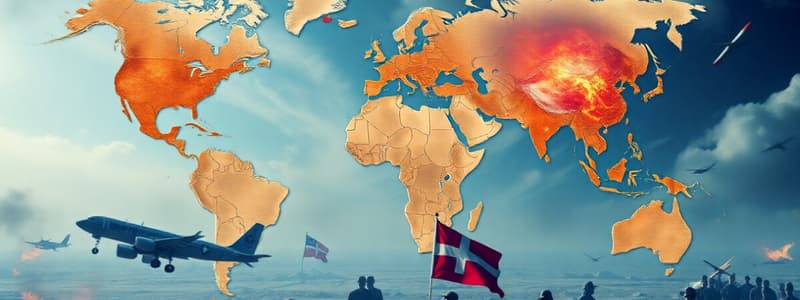Podcast
Questions and Answers
What major event was intended to be the 'war to end all wars'?
What major event was intended to be the 'war to end all wars'?
- World War I (correct)
- The Napoleonic Wars
- The American Civil War
- World War II
Which of the following factors contributed to the outbreak of World War II?
Which of the following factors contributed to the outbreak of World War II?
- Failure of the League of Nations
- The onset of the Cold War
- Economic prosperity of the 1920s
- Nazi expansion under Hitler (correct)
What significant change began in 1945 that affected world history?
What significant change began in 1945 that affected world history?
- Decolonization and collapse of European empires (correct)
- The rise of fascism in Europe
- The beginning of the Industrial Revolution
- The end of the American Civil Rights movement
Which processes marked the end of Cold War bipolarity?
Which processes marked the end of Cold War bipolarity?
What was one of the key influences on the collapse of the Soviet Union?
What was one of the key influences on the collapse of the Soviet Union?
What does the phrase 'war on terror' often suggest about global conflicts?
What does the phrase 'war on terror' often suggest about global conflicts?
How has globalization impacted the global economy?
How has globalization impacted the global economy?
What social and political movement intensified following the Cold War?
What social and political movement intensified following the Cold War?
Flashcards are hidden until you start studying
Study Notes
The Modern World
- The modern world was shaped by the collapse of ancient civilizations, the rise of Europe, and the growth of European imperialism.
- World War I, intended to be the “war to end all wars,” was followed by World War II within a generation.
- Key factors leading to World War II: WWI peace settlements, the global economic crisis of the 1930s, Nazi expansion, Japanese expansionism in Asia.
- 1945 marked a turning point in world history, initiating decolonization and the Cold War.
- The Cold War saw bipolar tensions between the US-dominated West and the Soviet-dominated East.
- The collapse of the Soviet Union in 1989–91 ended Cold War bipolarity.
- Factors contributing to the Soviet Union's collapse: structural weakness of Soviet-style communism, Gorbachev’s reforms, the "Second Cold War," economic and cultural globalization.
- The post-Cold War period saw initial "liberal" expectations, but these were challenged by rising ethnic nationalism and religious militancy.
- 9/11 and the “war on terror” heightened tensions, sometimes perceived as a clash between Islam and the West.
- Global power balances have shifted with globalization, some argue for US economic dominance, while others point to a multipolar global economy due to emerging economies.
Studying That Suits You
Use AI to generate personalized quizzes and flashcards to suit your learning preferences.



